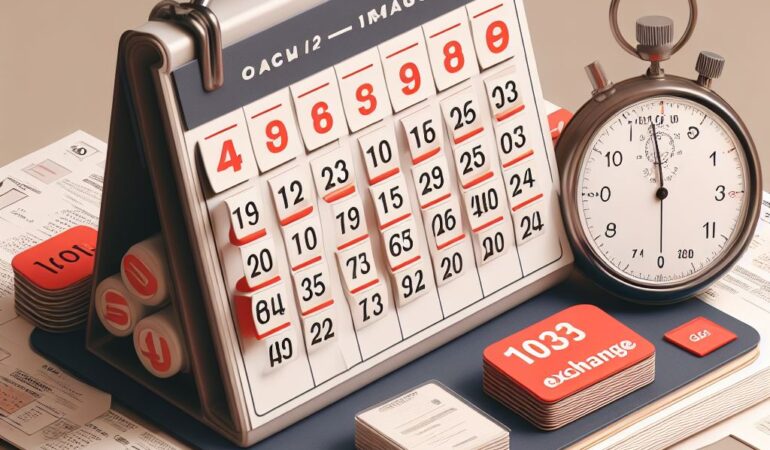Are you feeling the pressure of the approaching 1031 exchange deadline? Don’t worry, we’ve got you covered!
In this article, we’ll provide you with quick tips to ensure your success. Starting early, understanding the timelines, and working with a qualified intermediary are just a few of the strategies we’ll discuss.
By following these suggestions and staying organized throughout the process, you’ll be well-prepared to meet the deadline and make the most out of your 1031 exchange.
Key Takeaways
- Starting early is crucial for ample research, evaluation, and addressing potential issues.
- Understanding and adhering to the strict deadlines of the 45-day identification period and the 180-day exchange period is essential to maintain tax-deferred status.
- Working with a qualified intermediary ensures timely execution, compliance, and peace of mind.
- Proper documentation and organization of paperwork are necessary for a smooth and successful transaction.
Start Early
To maximize your chances of success with the 1031 exchange deadline, it’s crucial to start early. By beginning the process well in advance, you can avoid unnecessary stress and ensure a smooth transaction. Starting early allows you ample time to research and identify potential replacement properties that meet your investment goals. It also gives you the opportunity to thoroughly evaluate these properties and negotiate the best possible terms.
Additionally, starting early gives you more time to gather all the necessary documentation and work closely with your qualified intermediary to comply with the strict IRS regulations.
Beginning early also provides you with a competitive advantage. The 1031 exchange market can be highly competitive, and desirable replacement properties may be in high demand. By starting early, you can position yourself ahead of other investors and have a better chance of securing the property you desire.
Furthermore, starting early allows you to be proactive in addressing any unforeseen issues that may arise during the exchange process. It gives you the time to seek professional advice, consult with tax advisors, and address any potential roadblocks that could jeopardize the success of your exchange.
Understand the Timelines
To ensure a smooth and successful 1031 exchange, it’s crucial to understand the timelines involved. Familiarizing yourself with these timelines will help you navigate the process with confidence and avoid potential pitfalls.
The first timeline to consider is the identification period, which begins on the date of the transfer of the relinquished property and lasts for 45 calendar days. During this period, you must identify potential replacement properties in writing to the qualified intermediary. It’s essential to adhere to this strict deadline to maintain the tax-deferred status of your exchange.
Next, there’s the exchange period, which starts on the date of the transfer of the relinquished property and ends on the earlier of 180 calendar days or the due date of your federal tax return for the year in which the relinquished property was transferred. This timeframe encompasses the acquisition of the replacement property.
Understanding these timelines is crucial for a successful 1031 exchange. Failing to meet the deadlines can result in disqualification of the exchange and potential tax liabilities. To ensure compliance, it’s recommended to work closely with a qualified intermediary who can guide you through the process and help you meet all necessary deadlines.
Work With a Qualified Intermediary
Partnering with a qualified intermediary is essential to successfully navigate the timelines and requirements of a 1031 exchange. A qualified intermediary (QI) is a neutral third party who facilitates the exchange process and ensures compliance with IRS regulations. Here are three key reasons why working with a QI is crucial:
| Advantages of Working with a Qualified Intermediary | Explanation |
|---|---|
| Experience and Expertise | QIs have extensive knowledge of 1031 exchanges and can guide you through the process. They understand the complex rules and regulations, helping you avoid costly mistakes. |
| Timely Execution | QIs play a vital role in ensuring that the exchange is completed within the strict timelines set by the IRS. They handle all the necessary paperwork, including the identification and acquisition of replacement properties, ensuring a smooth and timely transaction. |
| Security and Compliance | By acting as a trusted intermediary, QIs help safeguard your funds throughout the exchange. They hold the proceeds from the sale of your relinquished property and ensure that they are properly reinvested in the replacement property, helping you maintain compliance with IRS regulations. |
Partnering with a qualified intermediary not only provides peace of mind but also increases the chances of a successful 1031 exchange. Their expertise, efficiency, and commitment to compliance can help you navigate the complexities of the process and meet the strict deadlines, ultimately maximizing your tax savings.
Prepare All Necessary Documentation
Once you have partnered with a qualified intermediary, it’s important to gather and prepare all the necessary documentation for your 1031 exchange. This is a crucial step in ensuring a smooth and successful transaction. To help you stay organized and ensure you have all the required paperwork, here are some key documents you’ll need to gather:
- Proof of Ownership: You’ll need to provide documents that establish your ownership of the relinquished property and the replacement property. This may include deeds, titles, or purchase agreements.
- Closing Statements: It’s important to obtain copies of the closing statements for both the relinquished property and the replacement property. These statements will provide details of the transaction, including the purchase price, any expenses, and any outstanding loans or liens.
- Exchange Agreement: You’ll need to have a properly executed exchange agreement with your qualified intermediary. This agreement outlines the terms and conditions of the 1031 exchange and ensures compliance with IRS regulations.
By gathering and organizing all the necessary documentation, you’ll be better prepared to navigate the 1031 exchange process. This won’t only save you time but also help you avoid any potential delays or complications.
Now that you have your documentation in order, let’s move on to the next section on how to stay organized throughout the process.
Stay Organized Throughout the Process
Make sure you stay organized throughout the 1031 exchange process to ensure a smooth and successful transaction. Keeping track of all the necessary documents and deadlines can be overwhelming, but with proper organization, you can navigate through the process with ease. Here are some tips to help you stay organized:
| Tip 1: Create a Checklist | Tip 2: Use a Dedicated Folder | Tip 3: Set Reminders |
|---|---|---|
| Create a checklist of all the required documents and tasks, such as property identification and closing dates. This will help you stay on top of everything and ensure nothing is missed. | Use a dedicated folder to store all the paperwork related to your 1031 exchange. This includes contracts, receipts, and any correspondence with your intermediary or real estate professionals. Having everything in one place will save you time and reduce the risk of losing important documents. | Set reminders for important deadlines and milestones in your calendar or smartphone. This will help you stay proactive and ensure you submit all required documents and meet all necessary deadlines. |
Frequently Asked Questions
Are There Any Exceptions to the 45-Day Identification Period and 180-Day Exchange Period for a 1031 Exchange?
There are exceptions to the 45-day identification period and 180-day exchange period for a 1031 exchange. However, it is important to consult with a qualified tax advisor for specific details regarding your situation.
Can I Use a 1031 Exchange to Defer Taxes on the Sale of a Second Home or Vacation Property?
You can use a 1031 exchange to defer taxes on the sale of a second home or vacation property. It’s a great way to save money and reinvest in new properties.
Is It Possible to Complete a 1031 Exchange if I Have Already Closed on the Sale of My Property?
Yes, it is possible to complete a 1031 exchange even after closing on the sale of your property. However, there are strict timelines and rules that must be followed to qualify for tax deferral.
Can I Use a 1031 Exchange to Defer Taxes on the Sale of a Property Located Outside of the United States?
Can you use a 1031 exchange to defer taxes on a property located outside the US? No, the 1031 exchange applies only to properties within the United States.
What Happens if I Am Unable to Identify a Replacement Property Within the 45-Day Identification Period?
If you are unable to identify a replacement property within the 45-day identification period, you may risk losing the opportunity to complete a 1031 exchange and defer taxes on your property sale.




